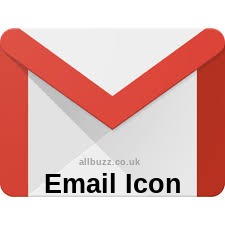The Power of the Email Icon: Why This Tiny Symbol Matters More Than You Think

Introduction: More Than Just a Little Envelope
Email Icon When you think of digital communication, what’s the very first image that pops into your head? For most people, it’s the little envelope symbol we all recognize as the. This tiny graphic may look simple, but it carries an incredible amount of weight in our online world. From business websites to mobile apps, and even social media platforms, the email icon has become a universal signpost pointing toward connection, communication, and opportunity.
While it might seem like just a design element, the email icon actually plays a far bigger role than many realize. It impacts how people interact with websites, whether they choose to reach out to a business, and even how brands build trust with their audiences. In fact, the email icon has become so deeply rooted in digital culture that it’s often used without a second thought, yet its effectiveness is undeniable.
In this article, let’s break down why the email icon is such a powerful tool, its history, the psychology behind it, and how businesses and individuals can make the most of this tiny but mighty graphic.
The Origins of the Email Icon

The email icon didn’t just appear out of nowhere—it has roots in traditional communication. The classic envelope design that we associate with email today comes directly from the physical envelopes that carried letters for centuries. Back in the early days of the internet, designers needed a way to visually represent the idea of sending and receiving digital letters. What better metaphor than the envelope?
This symbol caught on almost instantly because it was simple, familiar, and easy for people of all backgrounds to understand. Unlike complex tech jargon, an envelope didn’t need translation. Everyone already knew what it meant: a message was waiting for you. This universality is exactly why it became so iconic.
Over time, the design of the email icon has evolved. Some platforms kept the envelope, while others experimented with at-signs (@), paper airplanes, or notification dots. Still, the envelope remains the most widely recognized and trusted version, proving that sometimes the simplest design carries the most lasting power.
Why the Email Icon Still Stands Strong in a Changing World
We live in an age where messaging apps, social media DMs, and even video calls dominate communication. Yet, the email icon continues to thrive. Why? Because email itself hasn’t gone anywhere—it’s still one of the most reliable, professional, and universal forms of communication out there.
Think about it: you might not check your Facebook Messenger every day, but you almost certainly check your inbox. Businesses rely on email for official communications, receipts, promotions, and newsletters. Schools and universities use it for announcements. Governments use it to share information. Simply put, email is the backbone of modern communication, and the email icon is its visual ambassador.
Even more interesting is how the email icon has adapted. On smartphones, it’s not just a static symbol anymore—it’s often paired with a red notification badge showing unread counts. On websites, it doubles as a clickable link, opening your default email app. In design, it often appears next to social icons like Facebook, Instagram, and LinkedIn, ensuring brands remain accessible through multiple channels.
The Psychology Behind the Email Icon
Here’s something most people overlook: the email icon isn’t just a graphic—it’s a psychological trigger. When people see it, they instantly understand that there’s a direct way to reach out, ask questions, or connect with someone. It creates a sense of accessibility, which is especially important for businesses.
From a design perspective, the email icon also taps into trust. Unlike flashy pop-ups or aggressive chatbots, it’s subtle and familiar. Users feel safe clicking on it because they know what to expect. It doesn’t scream for attention; it calmly signals, “Hey, if you need me, I’m here.”
This trust factor is why businesses should never underestimate the importance of placing their email icon in visible locations, like website headers, footers, or contact pages. It’s not just about convenience—it’s about building a bridge of communication that customers are comfortable crossing.
The Role of the Email Icon in Branding
Believe it or not, the way you use an email icon can affect how people perceive your brand. A clean, minimal email icon in a website’s footer might project professionalism. A brightly colored, animated one could signal creativity or modern flair. Design choices matter, and the email icon is often one of the most overlooked branding tools.
For example, tech companies might prefer a sleek monochrome icon to fit their polished image. Lifestyle brands, on the other hand, may use playful or stylized icons to align with their vibe. Even something as simple as whether you use a filled or outlined version can make a difference in how your brand’s personality is communicated.
On top of that, placing the email icon alongside social media icons reinforces consistency. It shows that your brand is present everywhere, but also that it values traditional, reliable communication methods like email.
Email Icon Placement: Why Location Is Everything
You could have the most beautiful email icon in the world, but if it’s hidden where nobody can see it, it’s useless. Placement is absolutely key.
- Headers: Many websites place their email icon in the header so that it’s instantly accessible without scrolling. This is great for businesses that prioritize communication and want visitors to reach out easily.
- Footers: The footer is another common spot. It’s the “last stop” before a user leaves the page, so it makes sense to include your email icon here. People expect to find contact information at the bottom, so it works perfectly.
- Contact Pages: Of course, the contact page is an obvious location. Here, the email icon is usually paired with phone numbers, addresses, or contact forms, creating a full communication hub.
- Emails & Newsletters: Even within emails themselves, icons appear to encourage replies, follow-ups, or social connections.
Good placement ensures that users don’t waste time hunting for your contact details, which can directly improve engagement and conversions.
The Email Icon in UX and Web Design
User experience (UX) design is all about making digital spaces easier and more enjoyable to navigate. The email icon plays a surprisingly big role in this. Its familiar design eliminates confusion. Nobody ever has to ask, “What does that little envelope mean?” because they already know.
In UX, every click matters. An email icon reduces friction because it communicates function instantly. Designers often prefer icons over text links because they save space and look cleaner, especially on mobile devices. Plus, when paired with hover effects or animations, the icon can become more engaging without being intrusive.
As minimalism continues to dominate web design trends, icons like the email symbol are becoming more important than ever. They strip away unnecessary clutter while still carrying meaning.
Future of the Email Icon: Will It Ever Disappear?
With AI-driven chatbots, instant messengers, and emerging communication tools, one might wonder: will the email icon eventually fade away? The short answer is no—at least not anytime soon.
Email as a medium has proven itself remarkably resilient. It has survived the rise of social media, texting, and even video calling. Why? Because it serves a unique purpose that no other tool has fully replaced: professional, structured, and reliable communication. As long as email exists, the email icon will too.
What may change, however, is how the icon looks or functions. We might see more dynamic versions, perhaps animated or interactive, especially in app design. But the core idea—a recognizable symbol for email—will likely remain constant.
Conclusion: Small Icon, Big Impact
It’s easy to overlook the email icon as just another design element, but as we’ve seen, it carries enormous significance. It’s a bridge between people and businesses, a trigger for trust, and a symbol of communication that transcends cultural and language barriers.
From its origins as a simple envelope to its role in modern web design, the email icon proves that sometimes the smallest details can have the biggest impact. Whether you’re a designer, a marketer, or just someone who checks their inbox daily, the next time you see that little envelope, remember—it’s more than just a symbol. It’s the heartbeat of digital communication.



